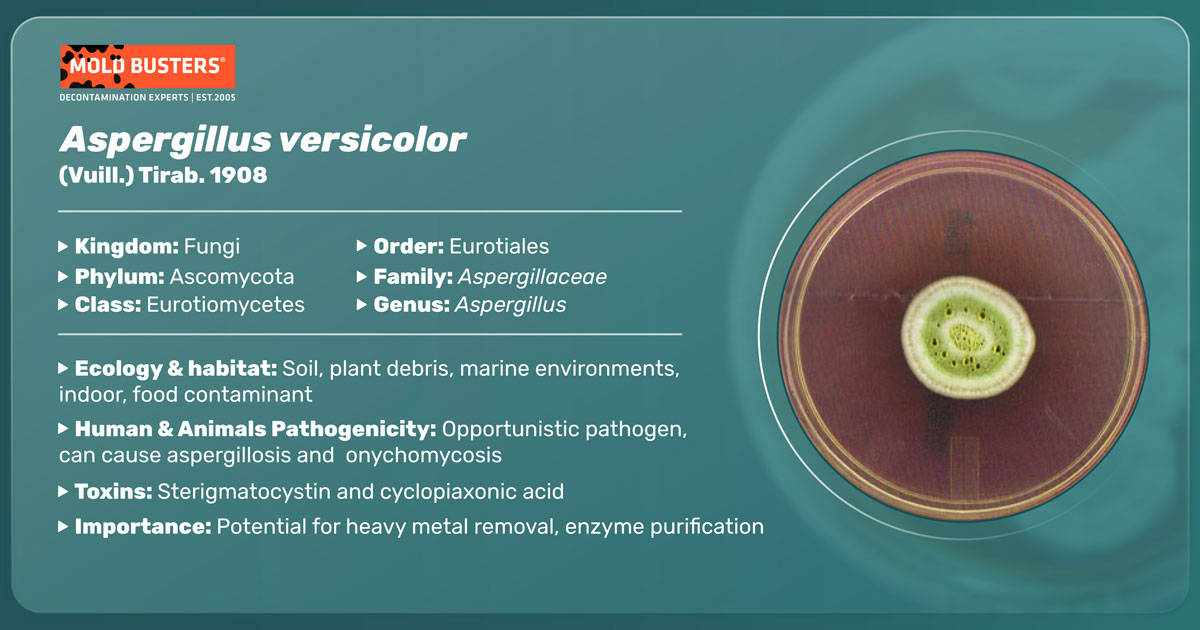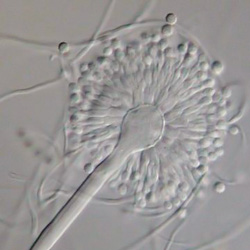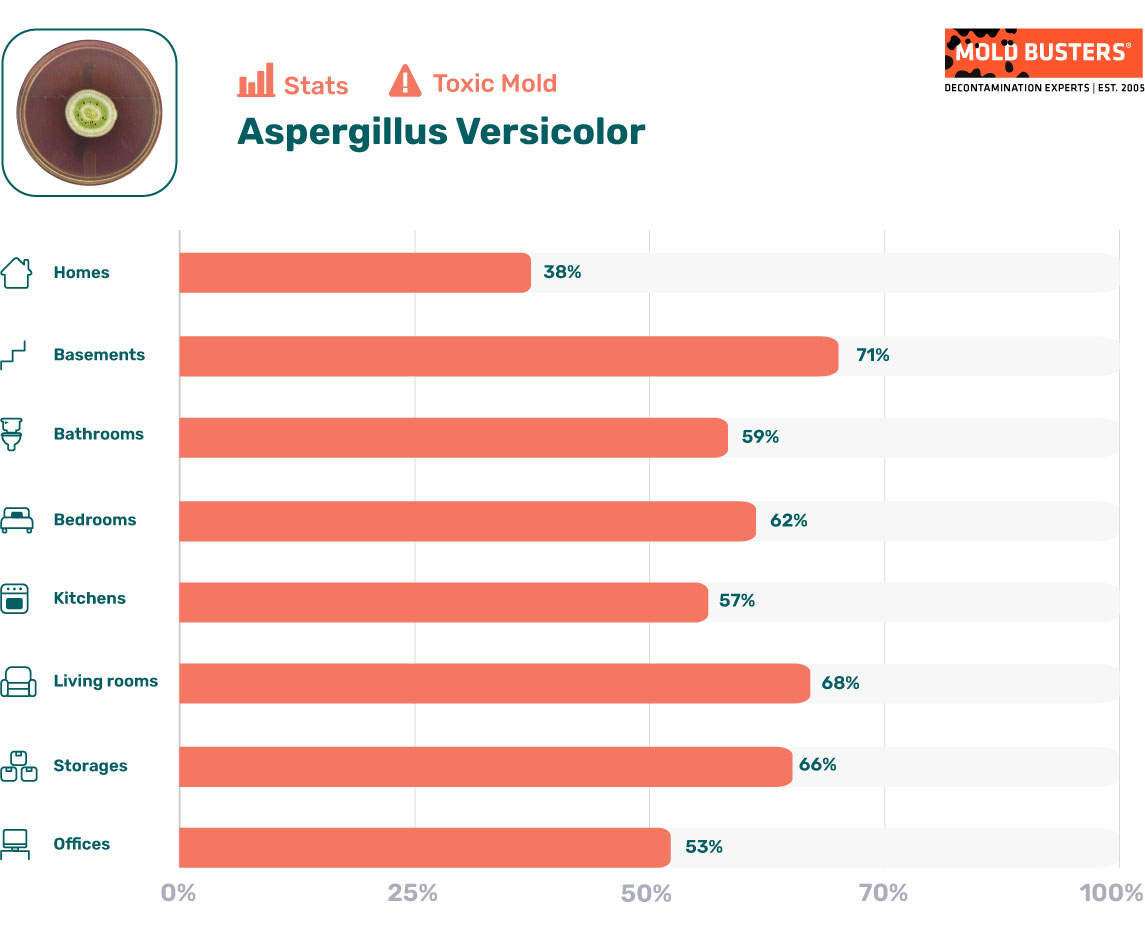(Vuill.) Tirab. 1908
What exactly is Aspergillus versicolor?
Aspergillus versicolor is a species of fungus belonging to the Aspergillus genus, which consists of approximately 200 species. It is commonly found in soil and decaying organic matter, and has been known to develop on many kinds of food, including cereal grains, seeds, nuts, dried meats, and dairy products [1]. It can frequently be found indoors, particularly on water-damaged buildings or materials such as wallpaper, carpets, and insulation. It has a musty or earthy odor and is a common indicator of moisture, humidity, and ventilation problems in buildings.
A. versicolor can produce mycotoxins (sterigmatocystin and cyclopiaxonic acid) that can cause diarrhea and an upset stomach if ingested in moderate quantities. Sterigmatocystin is structurally similar to aflatoxin B and has been reported to be a kidney and liver carcinogen [2]. However, A. versicoloris only occasionally pathogenic.
Aspergillus versicolor morphology

A. versicolor colonies grow up to 25 mm (1 inch) in diameter, with low and dense mycelium with a velutinous surface. The mycelium is white to buff, with numerous conidial heads giving the colony dull green color. Furthermore, depending on growth media, the colors can vary from yellow, tan, pale green, or pink over time (thus the species name “versicolor”). Conidiophores are often formed from aerial hyphae, 300–600 µm long, with yellow walls. Conidia are spherical, only 2.0–2.5 µm in diam, with roughened or spinose walls (Fig. 1).
What kind of mold is Aspergillus versicolor?

A. versicolor is osmophilic, meaning it can survive and reproduce in solutions with high osmotic pressure (high in sucrose or sodium chloride). It is also a xerophilic species, meaning it can grow in a relatively dry environment. In the optimal temperature range, it can grow at water activities as low as 0.75 [5]. These abilities allow the A. versicolor to be widespread and also to populate some extreme areas. A. versicolorhas even been found on Mir space station, survived both the launch to and the descent from space. [3]. A. versicolor has also been reported from the Dead Sea, one of the saltiest bodies of water on earth, and can survive Arctic conditions [4].
How quickly does the Aspergillus Versicolor grow?
A. versicolor can grow in temperatures ranging from 4-40°C (39-104°F), with its optimal growth range being between 22 and 26°C (71.6-78.8°F). As a general rule, you can expect a fresh growth of A. versicolorto take from 1 to 3 weeks to cover an area of about two square feet, especially in places that have seen recent water damage and remain damp.
Where can you find Aspergillus versicolor mold?
As mentioned earlier, all types of mold prefer to grow in damp places. In your home, this will usually mean places such as ventilation ducts, damp basements and attics, wallboards, and insulation fittings. The risk of developing the growth of mold becomes exponentially higher should there be a leakage somewhere or recent water damage in these places. The mold reproduces by producing airborne asexual spores. During prolonged exposure, these spores can negatively affect our health.
Aspergillus versicolor mold statistics
As part of the data analysis presented inside our Mold Statistics resource page, we have calculated how often mold spore types appear in different parts of the indoor environment when mold levels are elevated. Below are the stats for Aspergillus versicolor:


What allergies are caused by Aspergillus versicolor?
Allergies are excessively powerful reactions of our immune systems to allergens, or foreign materials, entering the body. A. versicolor spores are known allergens that may trigger allergic reactions in people who are particularly sensitive to them, with children, older people, and those suffering from lung conditions being most at risk.
The signs of an allergic reaction include:
- rashes
- headaches
- breathing difficulties
- running noses
- bloodshot eyes
- coughing
- sore, itching throat
Those with asthma are at a particularly high risk of experiencing difficulties related to A. versicolor exposure.
Can Aspergillus versicolor raise an infection?
Should an immunocompromised individual be exposed to a large quantity of A. versicolor spores, the mold can begin to grow in their lungs, causing a serious condition known as aspergillosis [6]. The mold can further form a hyphal ball in the lungs which then proceeds to extrude allergens and toxins directly into the patient’s bloodstream.
Once things have progressed to this point, there will be noticeable health effects including weight loss, coughing up blood, lack of energy, breathing difficulties, and persistent coughing. If left untreated, aspergillosis can potentially be fatal. However, this is rarely the case as antifungal treatment is usually very effective. It should be noted that our immune systems are perfectly equipped to fight off these pathogens, and most serious cases of aspergillosis occur in people with weakened immune systems, often as a result of another disease or treatment.
Aside from aspergillosis, A. versicolor has also been known to cause onychomycosis [7], which is a fungal nail infection. The nails will turn yellow or white, thicken considerably, before eventually falling off entirely.
Aspergillus versicolor and pneumonia
If a person’s immune system is already weakened as a result of conditions such as leukemia, AIDS, cancer, or recent organ transplantation, they might be at risk of developing invasive pulmonary aspergillosis which is a potentially deadly infection [8]. In cases where patients don’t respond to medication or surgery, the condition can eventually prove to be fatal.
Aspergillus versicolor treatment – How to get rid of it?
The best way to deal with A. versicolor spread is prevention. This can be done by ensuring our homes are free of conditions of any Aspergillus mold growths (excessive moisture and humidity). Should you ever notice signs of mold growth somewhere in or around your home, it’s best not to try and get rid of it on your own, no matter how simple it may look.
In the process of clearing the mold, you may not only be exposed to dangerous chemical fumes but also increased spore loads. Professional mold removal services are there to help you handle a mold outbreak safely and effectively.
We have a proven track record when it comes to mold removal. We can remove any hidden growths you might miss on your own provide advice on how to ensure the growth does not happen again in the future. Stay safe and call in the experts when dealing with any such hazardous situations.
References
- Pitt JI, Hocking AD (2009). Aspergillus and Related Teleomorphs. In: Fungi and Food Spoilage. Springer, Boston, MA, pp 474
- Díaz Nieto CH, Granero AM, Zon MA, Fernández H (2018). Sterigmatocystin: A mycotoxin to be seriously considered. Food Chem Toxicol. 118:460-470
- Makimura K, Hanazawa R, Takatori K, Tamura Y, Fujisaki R, Nishiyama Y, Abe S, Uchida K, Kawamura Y, Ezaki T, Yamaguchi H (2001). Fungal flora on board the Mir-Space Station, identification by morphological features and ribosomal DNA sequences. Microbiol Immunol. 45(5):357-63.
- Kis-Papo T, Oren A, Wasser SP, Nevo E (2003). Survival of filamentous fungi in hypersaline Dead Sea water. Microb Ecol. 45(2):183-90.
- Pasanen P, Korpi A, Kalliokoski P, Pasanen AL (1997). Growth and volatile metabolite production of Aspergillus versicolor in house dust. Environment International. 23 (4): 425–432.
- Kane S, Pinto JM, Dadzie CK, Dawis MA (2014). Aspergilloma caused by Aspergillus versicolor. Pediatr Infect Dis J. 33(8):891.
- Howard DH (2003). Pathogenic Fungi in Humans and Animals. Marcel Dekker, New York. pp 275-276
- Charles, M. P., Noyal, M. J., & Easow, J. M. (2011). Invasive pulmonary aspergillosis caused by Aspergillus versicolor in a patient on mechanical ventilation. The Australasian medical journal, 4(11), 632.

Get Special Gift: Industry-Standard Mold Removal Guidelines
Download the industry-standard guidelines that Mold Busters use in their own mold removal services, including news, tips and special offers:

Written by:
John Ward
Account Executive
Mold Busters
Edited by:
Dusan Sadikovic
Mycologist – MSc, PhD
Mold Busters
